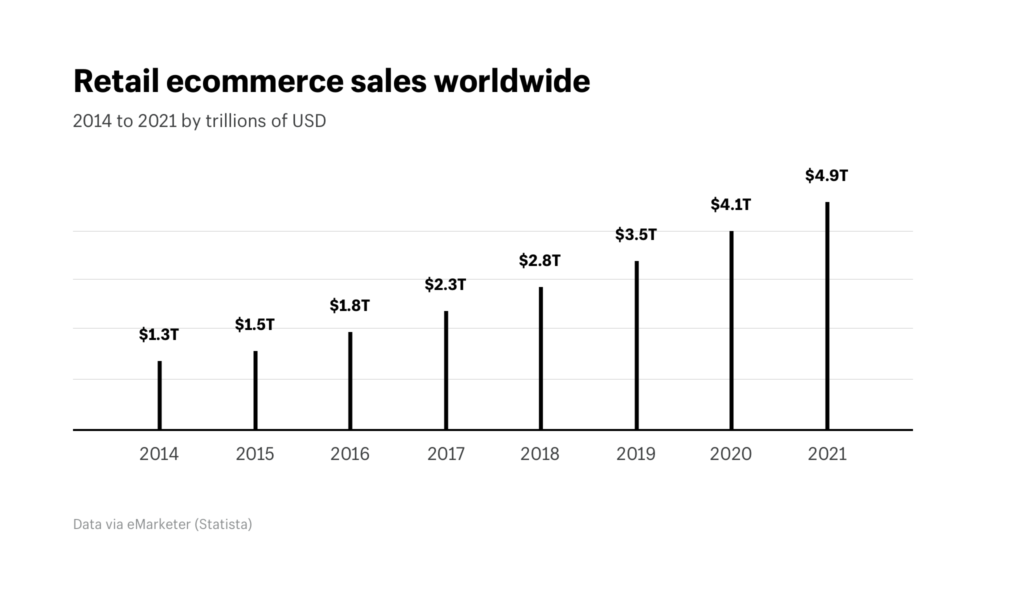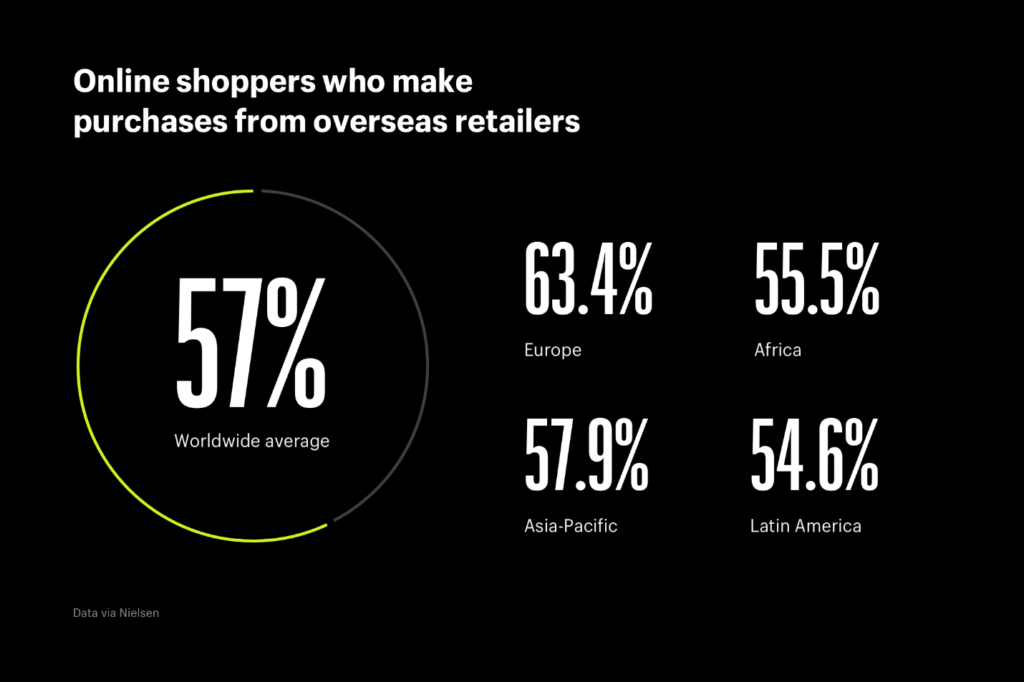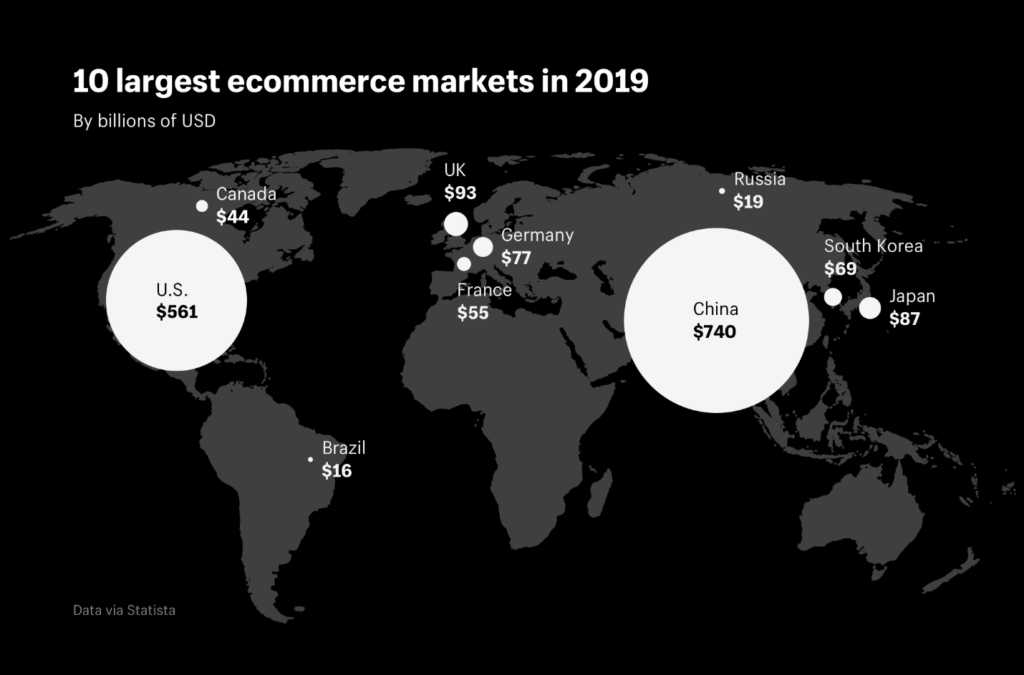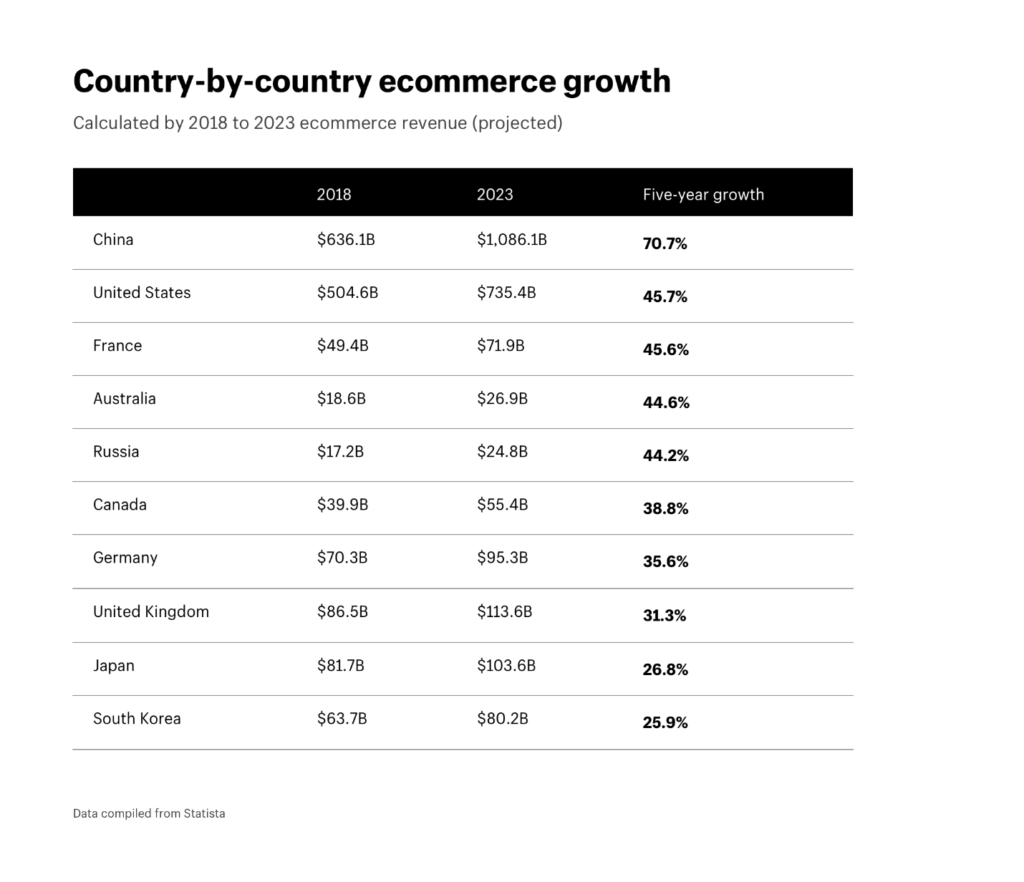Global Ecommerce Market Size
We define global ecommerce as selling products or services across geopolitical borders from a company’s country of origin – normally defined as its founding or incorporating location. Products or services are sold into non-native markets via online sales and marketing. Cumulative data anticipates a 276.9% increase in worldwide ecommerce sales over the most-recently tracked period.
 Numbers of that scale are hard to wrap our heads around. They’re at once invigorating and daunting. If your company is staring down that $4.5 trillion barrel and wondering, “Where do we begin?” rest assured, you’re not alone.
Numbers of that scale are hard to wrap our heads around. They’re at once invigorating and daunting. If your company is staring down that $4.5 trillion barrel and wondering, “Where do we begin?” rest assured, you’re not alone.
As Harvard Business Review wrote: “Business leaders are scrambling to adjust to a world few imagined possible just a year ago. The myth of a borderless world has come crashing down. Traditional pillars of open markets — the United States and the UK — are wobbling, and China is positioning itself as globalization’s staunchest defender.”
We’ll unpack that quote and more below. For now, the big idea is simple: the shadow of global ecommerce looms too large to ignore.
Domestic Shoppers Look Beyond Their Borders
To start, going global doesn’t necessarily require a global presence. Online shoppers are increasingly looking outside their country’s borders for purchases. In fact, during one six-month evaluation, overseas purchases were in the majority on all but one continent: North America.

Data via Nielsen
None of that demands multiple storefronts for each location or setting up international warehousing and fulfillment. One of the simplest ways to begin testing foreign markets is to prioritize online advertising or social media abroad. This requires an international approach to Google Ads, Product Listing Ads, Facebook, and Instagram through geographic targeting.
Ecommerce International Growth
Worldwide numbers aside, ecommerce’s regional markets rank as follows:
- Asia: $831.7 billion
- North America: $552.6 billion
- Europe: $346.5 billion
- Australia: $18.6 billion
- Africa and the Middle East: $18.6 billion
- South America: $17.7 billion
Looking at those same figures along country lines reveals the 10 largest ecommerce markets in the world currently are:

Of course, what truly matters isn’t where we are but where we’re going. Using 2023 projections, a slight reordering appears, as well as one standout leader: China.

Top Countries by average e-commerce revenue by online shopper
| Country | Average revenue per online shopper |
| United States | $1,804 |
| United Kingdom | $1,629 |
| Sweden | $1,446 |
| France | $1,228 |
| Germany | $1,064 |
| Japan | $968 |
| Spain | $849 |
| China | $626 |
| Russia | $396 |
| Brazil | $350 |
The Amazon Piece of the Ecommerce Pie
With 160.15 billion in net sales, the United States were Amazon’s biggest market in 2018. But while Amazon dominates the US ecommerce landscape, it’s a very different story overseas. In an effort to duplicate its domestic success, Amazon has doubled down on its international efforts, with Prime membership at the core of its expansion strategy.
What percent of worldwide retail ecommerce sales are attributed to Amazon? We forecast that Amazon will account for 48.0% of US retail ecommerce sales in 2018, making it the largest ecommerce platform in the country. It will make up 13.3% of worldwide retail ecommerce sales this year and just 5.6% when the US is excluded.
How many Amazon Prime members are outside the US? The number of international Amazon Prime subscribers (59.5 million) will surpass that of US subscribers (58.5 million) for the first time in 2018, according to J.P Morgan. Prime memberships are currently available in 17 countries: Austria, Australia, Belgium, Canada, China, France, Germany, India, Italy, Japan, Luxembourg, Mexico, the Netherlands, Singapore, Spain, the UK and the US.
What is Amazon’s largest market outside the US? Germany is Amazon’s largest foreign market, accounting for nearly one-third of its international net sales in 2017, according to the firm. Much of its success has to do with its wide-ranging product offering, low prices and a high degree of cross-border shopping from neighboring countries.
Which markets outside the US are being targeted by Amazon? Amazon continues to place its bets on India, a fast-growing ecommerce market where the firm has already had considerable success. It’s also one of the few countries where Prime Video is more popular than Netflix. Amazon also has a big opportunity with logistics in Latin America and recently established a local platform in Turkey.
How Big is Amazon’s Ecommerce Share?
Founded in 1994, Amazon has grown into one of the biggest e-commerce marketplaces and cloud computing platforms worldwide. In 2018, Amazon was ranked first in terms of company revenue among global publicly traded internet companies. With an annual revenue of almost 233 billion U.S. dollars, the e-retailer ranked far ahead of closest competitors Google (136.22 billion U.S. dollars) and Facebook (55.84 billion U.S. dollars).
As far as e-commerce, Amazon is the leading e-retailer in the United States. In 2018, an estimated 58.7 million households in the United States held a membership with the company’s subscription service Amazon Prime, benefitting from free 2-day shipping, music and video streaming and exclusive offers and deals. Amazon Prime members are very engaged shoppers: a February 2019 survey found that 20 percent of Amazon Prime shoppers made purchases on the website a few times a week, compared to only three percent of non-Prime shoppers. Using their regular account, an Amazon customer can seamlessly order from any regional Amazon site and also access third-party seller offerings from their local platform, enabling customers to make cross-border purchases without any extra effort.
Sources:
eMarketer: https://www.emarketer.com/content/amazon-around-the-world
Statista: https://www.statista.com/topics/3792/e-commerce-in-europe/
Insvesp: https://www.invespcro.com/blog/global-online-retail-spending-statistics-and-trends/




